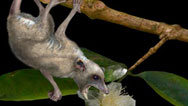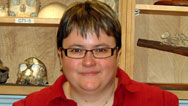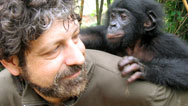First Primates
- Posted 07.09.08
- NOVA scienceNOW
(This video is no longer available for streaming.) As inhabitants of Earth, we humans are relative newbies. In fact, our branch of the evolutionary tree may have split from that of the apes only about six million years ago. But what if we look further back in our primate family tree? What would we find? As correspondent Peter Standring reports, the latest research is revealing that our origins may have been quite a bit humbler than we may have thought.
Transcript
First Primates
PBS Airdate: July 9, 2008
NEIL DeGRASSE TYSON: As inhabitants of Earth, we humans are relative newbies. In fact, our branch of the evolutionary tree may have split with these apes only about 6,000,000 years ago.
But what if we look further back in our primate family tree? There must have been some great and wise ancestor who founded this wonderful line of creatures, right? Well, as correspondent Peter Standring reports, the latest research is revealing that our origins may have been quite a bit humbler than we thought.
PETER STANDRING: The Badlands of Wyoming: some of the largest dinosaur bones, ever, were found right here. But University of Florida paleontologist Jonathan Bloch is hunting for a set of bones that are nothing like the giant bones of T-Rex.
JONATHAN BLOCH: Here's a little piece of bone here. Here's a little piece of bone. I think that's a little vertebra.
PETER STANDRING: Tiny mouse-sized bones, buried in limestone, that just might be the fossil remains of our earliest primate ancestors.
An age-old mystery surrounds the origin of primates. No one knows exactly where we come from or how we got our evolutionary start.
Here's what we do know: giant dinosaurs once ruled this basin, where they dined freely in a lush forest. But then, around 65 million years ago, the dinosaurs die off when a massive comet slams into the planet. Ten million years later, something extraordinary happens. The fossil record suddenly shows a new kind of mammal, with unique characteristics: the primate, our ancient ancestors.
So what is a primate? What is it that separates us from the rest of the evolutionary pack? Well, maybe it's our good looks or our superior intelligence.
The truth is brain size does come into play. We primates, even Noah here, have larger brains than our mammal relatives. It's a feature that evolved to help us learn complex social behavior and how to do things like make tools or even outwit our prey.
We also developed forward-facing eyes with stereo vision. It's a feature that allows us to judge the world around us in 3D. Over time, we also developed the ability to leap, basically to jump from branch to branch, where grasping hands, or in Noah's case, grasping feet, equipped with nails instead of claws, enable us to reach that tasty piece of fruit.
Our earliest ancestors developed these unique characteristics, some time after the extinction of dinosaurs. The question is, "When and why?"
So let me get it straight. If the dinosaurs became extinct 65 million years ago, and then primates suddenly appeared around 56 million years ago, what happened in between? I mean that's almost 10 million years that's unaccounted for.
JONATHAN BLOCH: Right. That's the $6,000,000 question. And I don't think they just appeared on the face of the planet, they evolved.
PETER STANDRING: But from what? I mean, something the size of a mouse?
JONATHAN BLOCH: Exactly.
PETER STANDRING: Jonathan believes the evidence to support his theory and help solve this ancient primate mystery can be found here, hidden inside the limestone of the Bighorn Basin.
JONATHAN BLOCH: A tiny little piece of broken bone can connect up with an entire skeleton of a mammal.
This looks like a pretty good limestone. It should be...should be full of fossils, but we really won't know until we get it back to the lab.
You see a tiny little piece of bone, and you hope that there's more inside, you have no guarantees, so it's a little bit of a gamble.
PETER STANDRING: But a gamble worth taking, because these stones might hold ancient clues.
JONATHAN BLOCH: These limestones allow us a window into that world that we've never had before.
PETER STANDRING: The world of the earliest primate. It will take a 2,000-mile drive back to his lab in Gainesville, Florida, and a year of painstaking work, to find out if Jonathan's gamble will pay off.
Back in his lab, Jonathan, along with graduate student Doug Boyer, gets to work. Their goal? To free the delicate bones from the rock-hard stone. They begin by placing the limestone under a microscope.
JONATHAN BLOCH: That immediately starts to open up the world of the block. We identify all of the bone that's outcropping on the surface.
PETER STANDRING: Doug carefully coats the tiny bones with plastic to protect them from the powerful acid bath they're about to take.
DOUG BOYER (Graduate Student, Stony Brook University): We leave the block in acid for, at the most, two to two and a half hours, and that'll remove about a millimeter-thick rind of limestone.
JONATHAN BLOCH: We repeat the process, again and again and again and again, until all of the bone is exposed.
PETER STANDRING: Much to their surprise they find hundreds of tiny bones. But success poses a new problem.
JONATHAN BLOCH: It's not always obvious which bones go to what animal, and so the only way to document that is by creating a little archeology site, a map of all the bones.
PETER STANDRING: Doug devises a method to meticulously document the relationship between each and every bone. The process will take months, but when complete, it will reveal far more than they ever anticipated: dozens of tiny mammals never before seen, including these three extraordinary skeletons.
And what are these?
JONATHAN BLOCH: These are plesiadapiforms,
PETER STANDRING: Plesiadapiforms are tiny mouse-like creatures that lived during the mysterious 10-million-year period between the extinction of dinosaurs and the appearance of primates. It's a very diverse group, with more than 120 species, including these three.
JONATHAN BLOCH: They represent the most complete skeletons of plesiadapiforms known in the world.
PETER STANDRING: An extraordinary find, for sure, but will they help Jonathan solve this primate mystery? Are plesiadapiforms our earliest ancestors?
JONATHAN BLOCH: If we look here, this nail-like structure makes you think, because the presence of a nail is a hallmark characteristic of living primates.
PETER STANDRING: This is an enlarged image of the extraordinary nail Jonathan found. Next to it, the claw he expected–a startling difference.
JONATHAN BLOCH: This nail might actually be the first nail in the history of primate evolution.
PETER STANDRING: Concrete evidence to support his theory of primate evolution. Could there be more hidden within these tiny bones?
To find out, Jonathan enlists the help of Mary Silcox, evolutionary anthropologist at the University of Winnipeg. She's been busy zapping primitive skulls with an industrial-strength CAT scanner, large enough to fill an entire room. Mary takes the skull of one of the limestone skeletons and prepares it for scanning.
MARY T. SILCOX (University of Winnipeg): The x-ray goes through the specimen, and we collect 2,400 separate views, which produce a cross-sectional image.
A structure that had been identified as just a little piece of bone in the middle ear actually had the form of a tube. And the reason that was exciting was because there's a structure running through the ear of particularly primitive primates–things like lemurs–which is a tube for a large vessel that goes to the brain.
PETER STANDRING: A tiny tube, a tiny nail, the evidence is mounting. But to prove his theory of primate evolution, Jonathan still needs more. He adds another member to the team. Eric Sargis, professor of anthropology at Yale University, and the world's leading expert on tree shrews. Why a tree shrew expert? Scientists believe that tree shrews–a primitive species of tiny tree-living mammals–are actually related to early primates.
ERIC SARGIS: Tree shrews are not primates, but they're close relatives. They share a number of characteristics that separates them from other groups of mammals.
PETER STANDRING: Would plesiadapiforms pass the ultimate primate test? Are they the first step on the primate family tree or just another relative on the tree shrew family tree?
MARY SILCOX: What we were interested in was to test whether or not plesiadapiforms were the earliest primates.
PETER STANDRING: The team goes to work bringing together all the information they had collected independently into a single comprehensive study: Jonathan and Doug's plesiadapiform skeletons; Mary's scans of dozens of ancient skulls; and Eric's anatomical data on a close living relative, the tree shrew.
ERIC SARGIS: The way we start is by comparing all these specimens.
PETER STANDRING: Detail by detail, feature by feature they combed through all the data using a numerical system to compare and contrast.
JONATHAN BLOCH: After we studied the different characteristics of these animals, and reduced them down to numbers–you know, absence of a nail is a 0, presence of a nail is a 1–we then ran this through a computer algorithm.
PETER STANDRING: The algorithm sifted through the complex data in search of simple relationships: which fossils have the same characteristics, the same numbers. Using this information, the computer was programmed to create family trees illustrating the potential relationships each mammal has to the next. The team expected the computer to come up with several possible scenarios in the form of several possible family trees. Instead, the program came up with only one.
JONATHAN BLOCH: I was a little surprised to see it so unambiguous.
PETER STANDRING: This single family tree could lead to only one conclusion.
JONATHAN BLOCH: I think the evidence, as it stands today, is pretty compelling that yes, in fact, these are primates.
MARY SILCOX: Every new piece of data that we had coming out of our study of this material seemed to be consistent with that idea.
PETER STANDRING: Not only that. One of the plesiadapiform skeletons Jonathan and Doug painstakingly etched out of limestone, a species by the name of Dryomomys, turns out to be far more primitive than the other two, possessing only one primate characteristic, the shape of its teeth.
ERIC SARGIS: It's sort of a transitional specimen between more primitive things, like tree shrews, and later primates.
PETER STANDRING: One part primate, other parts not.
ERIC SARGIS: I mean, it really starts to tell us something about the base of the primate tree, what the earliest primates look like. So, if we're one leaf on the branch, so are chimpanzees, gorillas, orangutans, among apes; all the different monkeys in the old world and the new world; lemurs from Madagascar; lorises and galagoes; all those animals are living today, but you can trace it all back to a single common ancestor. And as you get closer and closer to that common ancestor, dryomomys is one of the animals that's closest to the base there. It's the most primitive primate skeleton ever found, to date.
PETER STANDRING: Jonathan had evidence to support his theory. Primates didn't just appear on the planet, they evolved over a 10-million-year period. And just as he thought, the earliest primates were the size of a mouse. Still one question remains. What sparked this amazing transformation? The team believes our ancient ancestors evolve on the heels of a mass extinction. Without the mighty T-Rex around, the tiniest of mammals are free to forage and explore, and they discover a world filled with flowering plants and succulent fruit.
MARY SILCOX: We have this sort of co-evolutionary relationship, where fruits were evolving to get tastier for primates to eat; the primates were then eating them and helping the plants actually spread their seeds further.
PETER STANDRING: With tempting fruit growing at the end of tiny branches, our ancestors have plenty of motivation to change. So they begin to evolve, developing long fingers for climbing trees, specialized teeth, hands and feet, uniquely designed for grasping and eating the tiniest, tasty berry. Over 10 million years, they slowly develop unique characteristics that we recognize in our primate relatives and ourselves.
ERIC SARGIS: So that if plesiadapiforms don't evolve, we're probably not standing here talking about this right now.
Credits
- Edited by
- David Chmura
- Produced and Directed by
- Terri Randall
- Executive Producer
- Samuel Fine
- Executive Editor
- Neil deGrasse Tyson
- Senior Series Producer
- Vincent Liota
- Supervising Producers
-
Stephen Sweigart
Joey David - Editorial Producer
- Julia Cort
- Development Producer
- Vinita Mehta
- Senior Editor
- David Chmura
- Online Editor
- Laura Raimondo
- Series Production Assistant
- Fran Laks
- Assistant Editors
-
Susan Perla
Tung-Jen (Sunny) Chiang - Compositors
-
Brian Edgerton
Yunsik Noh
Tristian Goik - Music
- Rob Morsberger
- NOVA scienceNOW Series Animation
- Edgeworx
- Associate Producers
-
Melanie Cunningham
Jeff Marion
Steven Reich - Camera
-
Chad Baron
Joseph Brunette
Mark Carroll
Joseph Friedman
Sean Glenn
Mark Gunning
Jerry Hattan
Edward Marritz
Michael D. McClare - Sound Recordists
-
Chad Baron
Tom Eichler
Dennis Hrbek
Charlie Maccarone
Janice Mahan
Mark Mandler
Pete Nenortas
JR Rodriguez
Paul Rusnak
Dennis Sprankel
Robert Sullivan
John van der Does - Sound Mix
- David Chmura
- Animation
-
Brian Edgerton
Sputnik Animation
James LaPlante - Production Assistants
-
Daniel Sites
Elizabeth Stachow
Bobby Tucker - For Lone Wolf Documentary Group
-
- Executive Producer
- Kirk Wolfinger
- Production Manager
- Donna Huttemann
- Archival Material
-
American Broadcasting Companies
BBC
Larry Burrows Estate
Janice Carr
Wade B. Clark Jr.
Corbis
Friedman Archives
ITN
Utako Kikutani
NASA
National Geographic
NewspaperArchive.Com
NIAID/RML
Streamline Films
Adam Zoghlin, Timelapse.com - Special Thanks
-
Comunidad Inti Wara Yassi
Tim Endy, MD
Goddard Space Flight Center
Gerard Irzyk, PhD, 454 Life Sciences
Meena Hartenstein
Lance Corporal Tim Lang
Nicholas Ornston, PhD
Penn State University
The Crew of SM-4
Walter Reed Army Medical Center
Eric Sargis
Michael Snyder, PhD
The Snyder Lab, Yale University
Arjun Srinivasan, MD
University of Florida
Bob and Lee Woodruff
Glenn Wortmann, MD
Yale University - NOVA scienceNOW Consortium Stations
-
Nebraska Educational Telecommunications, NET
Public Broadcasting for Northern California, KQED
Twin Cities Public Television, TPT
Wisconsin Public Television, WPT - NOVA Series Graphics
- yU + co.
- NOVA Theme Music
-
Walter Werzowa
John Luker
Musikvergnuegen, Inc. - Additional NOVA Theme Music
-
Ray Loring
Rob Morsberger - Post Production Online Editor
- Spencer Gentry
- Closed Captioning
- The Caption Center
- Publicity
-
Carole McFall
Eileen Campion
Lindsay de la Rigaudiere
Victoria Louie
Kate Becker - Senior Researcher
- Gaia Remerowski
- Production Coordinator
- Linda Callahan
- Paralegals
-
Raphael Nemes
Sarah Erlandson - Talent Relations
-
Scott Kardel, Esq.
Janice Flood - Legal Counsel
- Susan Rosen
- Post Production Assistant
- Darcy Forlenza
- Associate Producer, Post Production
- Patrick Carey
- Post Production Supervisor
- Regina O'Toole
- Post Production Editors
-
Rebecca Nieto
Alex Kreuter - Post Production Manager
- Nathan Gunner
- Compliance Manager
- Linzy Emery
- Business Manager
- Joseph P. Tracy
- Producers, Special Projects
-
Lisa Mirowitz
David Condon - Coordinating Producer
- Laurie Cahalane
- Senior Science Editor
- Evan Hadingham
- Senior Series Producer
- Melanie Wallace
- Managing Director
- Alan Ritsko
- Senior Executive Producer
- Paula S. Apsell
Neil deGrasse Tyson is director of the Hayden Planetarium in the Rose Center for Earth and Space at the American Museum of Natural History.
This material is based upon work supported by the National Science Foundation under Grant No. 0638931. Any opinions, findings, and conclusions or recommendations expressed in this material are those of the author(s) and do not necessarily reflect the views of the National Science Foundation.
NOVA scienceNOW is a trademark of the WGBH Educational Foundation
NOVA scienceNOW is produced for WGBH/Boston by NOVA
© 2008 WGBH Educational Foundation
All rights reserved
- Image credit: (Carpolestes) © Doug M. Boyer, artist
Participants
- Jonathan Bloch
- Florida Museum of Natural History www.flmnh.ufl.edu/directory/cvs/jbloch_cv.htm
- Doug Boyer
- Duke University
- Neil deGrasse Tyson
- Astrophysicist, American Museum of Natural History www.haydenplanetarium.org/tyson/profile/bio
- Eric Sargis
- Professor, Yale University www.yale.edu/anthropology/people/esargis.html
- Mary T. Silcox
- University of Winnipeg www.uwinnipeg.ca/faculty/anthropology/pages/silcox/main.html
- Peter Standring
- Correspondent
Related Links
-

Meet Your Ancestors
Take a look at your primate kin over the past 55 million years.
-

First Primates: Expert Q&A
Evolutionary anthropologist Mary Silcox answers your questions about the world's premiere primates.
-

The Gap Between Humans and Apes
Recent brain imaging research is offering new insights.
-

Our Family Tree
See (and hear) where you stand among the great apes in this audiovisual interactive.
-

Who's Who In Human Evolution
Meet your increasingly distant cousins in this clickable illustration of the past seven million years.



